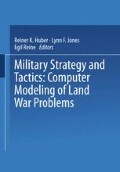Abstract
IDA Ground-Air Model I (IDAGAM I) is a deterministic, fully automated model of nonnuclear combat between two opposing sides. This model is the latest in what might loosely be called a family of models that began with ATLAS (Kerling and Cole [191) and led first to GACAM (Bracken, et al.[12]), then to GACAM II (Bracken, et al. [11]), and then to IDAGAM I. This is a “loose” family because the only thing that really ties it together is that the developers of each succeeding model, before developing that model, looked closely at the advantages and limitations of its predecessors. These models were not developed at the same place or under the same funding; and, with the exception of Edward Kerlin, they were not developed by the same people.
Access this chapter
Tax calculation will be finalised at checkout
Purchases are for personal use only
Preview
Unable to display preview. Download preview PDF.
References
Anderson, L.B.: A Method for Determining Linear Weighting Values for Individual Weapons Systems,Working Paper WP-4, Improved Methodologies for General Purpose Forces Planning (New Methods Study), Institute for Defence Analyses, Revised April 1973.
Anderson, L.B.: A Brief Review of Some Air-to-Air Models, Working Paper WP-29, Improved Methodo-logies for General Purpose Forces Planning (New Methods Study), Institute for Defence Analyses, August 1, 1972.
Anderson, L.B.: Some Comments on the Use of An ATLAS-Type Model to Evaluate Replacement Policies,Working Paper WP-62, Improved Methodologies for General Purpose Forces Planning(New Methods Study), Institute for Defence Analyses, January 22, 1973.
Anderson, L.B.: A Brief Description of How Relative Weapon Density Can Be Introduced Into Attrition Calculations, Working Paper WP-69, Improved Methodologies for General Purpose Forces Planning ( New Methods Study ), Institute for Defence Analyses, April 1973.
Anderson, L.B.: A Discussion on How the Contribution of Air Power Should be Considered in Force Ratios for Determining Casualties, Working Paper WP-2, Project 23–21, Institute for Defence Analyses, July 1973.
Anderson, L.B.: The Calculation of Force Ratios From Firepower Matrices Based on a Casualty Approach, Working Paper WP-1, Project 23–22, Institute for Defence Analyses, July 1973.
Anderson, L.B.: The Relationship Between IDAGAM I and the Limitations of GACAM II, Working Paper WP-5, Project 23–22, Institute for Defence Analyses, August 1973.
Anderson, L.B.: A Summary of the Differences Between GACAM II and IDAGAM I, Working Paper WP-6, Project 23–22, Institute for Defence Analyses, August 22, 1973.
Anderson, L.B.Bracken, J.: An Example Calculation for the IDAGAM Attrition Process, Working Paper WP-2, Project 23–22, Institute for Defence Analyses, July 1973.
Bracken, J.: Two Optimal Sortie Allocation Models - Vol. I: Methodology and Sample Results;Vol. II: Computer Program Documentation, Institute for Defence Analyses, Paper P-992, December 1973.
Bracken, J.: Ground-Air Campaign Model II (GACAM II), Smooth Draft, Institute for Defence Anderson, L.B. Analyses, 2 March 1973. Boylan, F. Kerlin, E.P.Luttrell, D.A.
Bracken, J.: Methodologies for General Purposes Forces Planning (in to volumes), WSEG Report 165 (IDA Report R-175), April 1971, SECRET.
Dare, D.P.: The Derivation of Some Parameters for a Corps/Division Model From a Battle Group James, B.A.P. Model, Defence Operation Analysis Establishment Memorandum 712o, Ministry of Defence, West Byfleet, United Kingdom, July 1971, CONFIDENTIAL.
Molter, W.H. et al. Appendix D: NATO Combat Capabilities Analysis II (COMCAP II) (U), GRC Report OAD-CR-8, General Research Corporation, McLean, Virginia, August 1973, SECRET (Appendix D is unclassified).
Karr, A.F,: Stochastic Attrition Models of Lanchester Type, Institute for Defence Analyses, Paper P-1o3o, June 1974.
Kerlin, E.P.: Comments on the Replacement Policy Issue (U), Working Paper WP-63, Improved Methodologies for General Purpose Forces Planning (New Methods Study), Institute for Defence Analyses, January 31, 1973, SECRET.
Kerlin, E.P.: A Stylized Analysis of the Replacement Problem, Working Paper WP-66, Improved Methodologies for General Purpose Forces Planning ( New Methods Study ), Institute for Defence Analyses, February 1973.
Kerlin, E.P.: ATLAS: A Tactical, Logistical and Air Simulation ( Documentation and User’s Guide),Cole, R.H. Research Analysis Corporation, April 1969.
Newman, J.T. et al.: Theater Force Evaluation System for CONAF (Conceptual Design for the Army in the Field), Vol II: Methodology, Research Analysis Corporation, May 1972.
Spudich, J.: The Relative Kill Productivity Exchange Ratio Technique, Booz-Allen Applied Research, Inc., Combined Arms Research Office, n.d.
Thrall, R.M. and Associates: Chapter 2.C., Final Report to US Army Strategy and Tactics Analysis Group (RIT-200-R4–33), May 1972. (This reference is virtually identical to David R. Howes and Robert M. Thrall: Chapter 2.C., Final Report to US Army Strategy and Tactics Analysis Group (RIT-200-R4–33), May 1972. (This reference is virtually identical to David R. Howes and Robert M. Thrall, “A Theory of Ideal Linear Weights for Heterogeneous Combat Forces”, Naval Logistics Research Quarterly, Vol. 2o, No. 4, December 1973.
U.S. Air Force, ACS, SA:Methodology for Use in Measuring the Effectiveness of General Purposes Forces ( An Algorithm for Approximating the Game Theoretic Value of N-Staged Games ), SABER GRAND (ALPHA ), March 1971.
U.S. Army, Combat Developments Command, Headquarters, TAB E, Appendix II to Annex L, Tank, Anti-Tank and Assault Weapons Requirements Study (U), Phase III ( TATAWS III ), December 1968, SECRET-NOFORN (Tab E, Appendix II to Annex L is unclassified. )
Author information
Authors and Affiliations
Editor information
Editors and Affiliations
Rights and permissions
Copyright information
© 1975 Springer Science+Business Media New York
About this chapter
Cite this chapter
Bracken, J., Anderson, L.B., Healy, J.G., Hutzler, M.J., Kerlin, E.P. (1975). A Summary of IDA Ground-Air Model I. In: Huber, R.K., Jones, L.F., Reine, E. (eds) Military Strategy and Tactics. Springer, Boston, MA. https://doi.org/10.1007/978-1-4757-0958-2_23
Download citation
DOI: https://doi.org/10.1007/978-1-4757-0958-2_23
Publisher Name: Springer, Boston, MA
Print ISBN: 978-1-4757-0960-5
Online ISBN: 978-1-4757-0958-2
eBook Packages: Springer Book Archive

